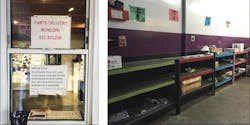What It Is: Color-coded shelves for storing parts
The Inspiration: Bogi Lateiner says that it was always a problem—her technicians at 180 Degrees Automotive had no way of being notified when a part needed for a repair had arrived. When parts came in, they were all being put in the same place. So, if multiple sets of brakes came in, for example, the technicians didn’t know which ones were theirs. The issue only amplified when the business moved into a larger facility in 2012. Not only was there no precise system in place, but also the physical distance between the service advisors (who managed the parts orders) and the technicians was significant. Trips back and forth between the repair bays and the service advisor desk to check on parts became a real time-waste and a drain on the shop’s efficiency.
The problem was brought up at one of the shop’s weekly staff meetings. Lateiner’s team wanted to keep the system as simple and self-managing as possible. Throughout the course of several meetings, the technicians helped guide the process into what it is today.
What It Does: When service advisors place parts orders, they enter the purchase orders into the shop’s management system. Each purchase order is assigned the last three digits of the invoice and then a color that correlates to the technician working on that particular job. When the order comes in, Lateiner’s parts team simply looks at the order information and puts the part on the corresponding shelf.
The techs are responsible for keeping their shelves clean. They each have two. The bottom shelf, which is more tucked away, is usually reserved for parts that will not be used right away. More immediate parts are put on the top shelf in plain sight. The shelves are regularly checked and cleared so the technicians know what needs to be done. “It’s very self-regulating,” Lateiner says. “What makes it so successful is that my techs were a part of creating it. They own it as their system.”
How It’s Made: The process is simple, but extremely effective. Each technician has a shelving unit with an upper and lower bench. Each assigned shelf is marked with the specific technician’s designated color. The shelves are marked with that specific color masking tape and a sign is placed above the shelf that has the color written out in that color. For example, the red shelf is taped off in red with a red sign that says R-E-D.
Cost: $250 for the shelves, masking tape, and signs.
ROI: “It just makes things flow smoother,” Lateiner says. She estimates that it has probably saved a half hour per day per technician, allowing the shop to push more vehicles through.



